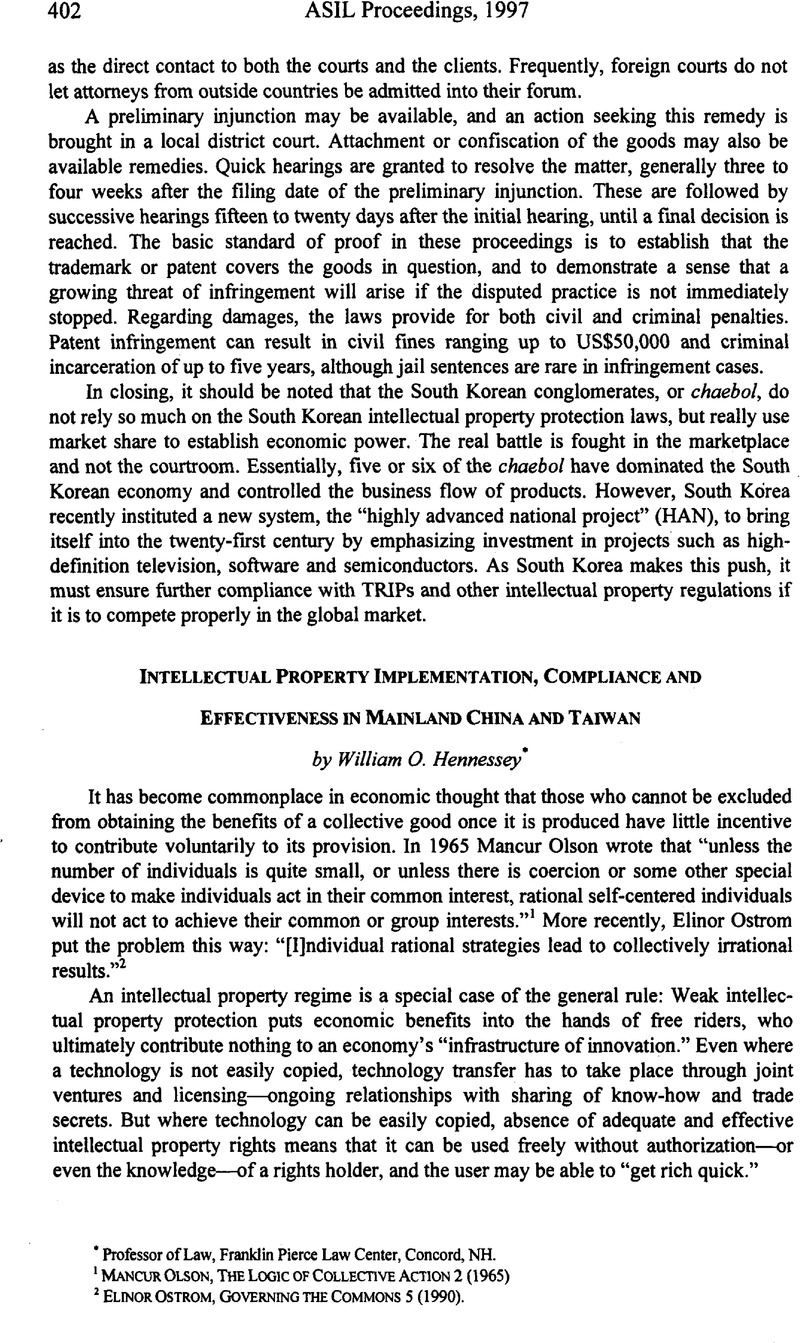No CrossRef data available.
Published online by Cambridge University Press: 28 February 2017

1 Mancur Olson, The Logic of Collective Action 2 (1965)
2 Elinor Ostrom, Governing the Commons 5 (1990).
3 Determination Involving Expeditious Action; Proposed Determination Concerning What Further Action to Take under Section 301(a) in Response to the People’s Republic of China’s Unsatisfactory Implementation of the 1995 Agreement on Enforcement of Intellectual Property and Market Access, 61 Fed. Reg. 25, 000 (1996); Identifications of Countries under Section 182 of the Trade Act of 1974: Request for Public Comment, 62 Fed. Reg. 1142 (1997). In identifying countries that deny adequate protection for intellectual property rights, the Trade Representative “shall take into account such information as may be submitted to the Trade Representative by interested persons, including .. . information contained in . .. petitions submitted under section 302.” 19 U.S.C. § 2242(b)(2)(B). All references to factual allegations in the following paragraphs are taken from petitions filed with the Trade Representative in February 1997. See also Office of the U.S. Trade Representative, National Trade Estimate <http://www.ustr.gov/reports/nte/l997/contents.html>.
4 Ministry of Foreign Trade and Economic Cooperation [MOFTEC] Tan et. Al, Asia Pacific Review of the Year: China, 67 Copyright World 19, 20 (Feb. 1998)Google Scholar.
5 Id.
6 11 World Intell. Prop. Rep. 53 (Feb. 1997).
7 Adrien Orten, Les Suites d’l’Accord de Marrakech et la propriété intellectuelle: La mise in place de l’OMC, Remarks at ATRIP Annual Meeting, Casablanca (Sept. 6, 1996).
8 Wang, Huijong Et Al, Industrialization and Economic Reform in China 167 (1995)Google Scholar.
9 Roy, Uprendra, Tuch, Robert D. & Clark, Joseph E., Global Assessment of Patents, R&D Investment and Economic Output: Part I—Macro Comparisons at the Country Level, 79 J. Pat. & Trademark off. Soc’y 110, 118 (1998)Google Scholar.
10 Mark Abell, Is China More Advanced than the West in its Approach to Brand Valuation?, Trademark World, Mar. 1997, at 17-19.
11 Id.
12 Shaojie Chi, Liability Issues are Consideration in China Licensing, XXXI Les Nouvelles: J. Licensing Executives Soc’y, Dec. 1996, at 179-82.
13 Shaojie Chi, The Current Business Secret Protection Mechanism in China, China Pat. & Trademarks, Jan. 1997, at 68, 72.
14 Id.
15 Lulin Gao, China and the TRIPs Agreement, China Pat. & Trademarks, Jan. 1997, at 3, 5.
16 Shaojie Chi, Administrative Action in China for IPR Cases, XXXI Les Nouvelles: J. Licensing Executives Soc’y, Mar. 1997, at 30-35.
17 China: A Funny-looking Tiger, The Economist, Aug. 17, 1996, at 17, 19.
18 See generally William P. Alford, To Steal a Book is an Elegant offense: Intellectual Property Law in Chinese Civilization (1994); I-IV Joseph Needham, Science and Civilization in China (1954-1995).